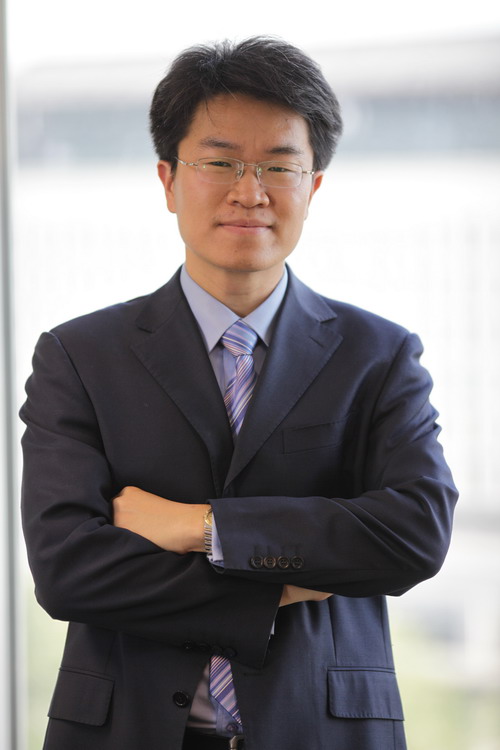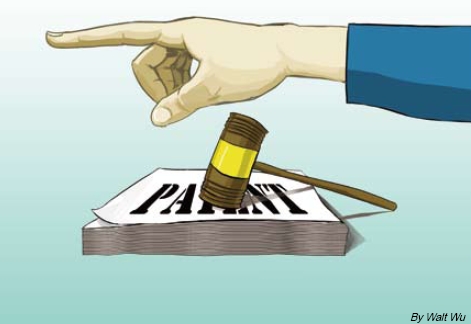An auction is not as “horrifying” as people usually think. Zhu Haibo had witnessed and participated in two intensive patent auctions, his casual statement, juxtaposed with the uncertain surprises that arose during the auctions, have helped China IP journalist get a taste for what the environment must have been like.
On the Spot Gaming
In 2010, Zhu Haibo, patent agent and partner of Beijing Hanhow Intellectual Property Partners, took part in the first patent auction held by the China Technology Exchange (CTEX). At that time, his intention was to do no more than observe and learn about the event, which was novel to him. Zhu Haibo told China IP that before the auction took place he had already sent the list of bidding items to his clients.
 |
| Bidder--Zhu Haibo |
Many clients were intrigued by the newly emerged “patent auction,” but still took a conservative attitude. Thus, as a “pioneer,” Zhu Haibo extended his “antenna” at the auction to collect information. He had a very deep impression on the first patent auction, “I remember that the highest bidding price reached up to 1.2 million yuan. The competition was quite fierce.” Ever since the initial participation, Zhu Haibo’s sharp observation and professionalism have never allowed him to keep his eyes away from patent auctions. Thereafter, successful cases of patent auctions, successful operation modes both at home and abroad, patent evaluation and other related issues have become the focus of his attention as well as the core of his research. In 2011, CTEX held the second patent auction. One of Zhu Haibo’s clients picked out five items without reserve prices and made a preliminary plan to get two of them. With this mission, Zhu Haibo became a true “fighter” on the auction “battle field.” Following the auction order, Zhu Haibo successfully bid for two items, but only because of the lack of competitors. The news surprised his client and he was asked to bid for the other three items. By the time he returned, the other three items had been auctioned off. With regret from the last auction, Zhu Haibo is particularly looking forward to redemption at the third patent auction, which will be held this year.
Bidding Strategies
Based on his personal experiences from the two patent auctions held by CTEX and his deepened understanding of domestic and foreign patent auctions thereof, Zhu Haibo summarized his own “bidding strategies.”
Strategy 1: Choosing the Bidding Items.
Up to date, CTEX is still looking for the right path to patent auctions. One issue is determining how to solicit bidding items. On the issue of whether to cooperate with scientific research institutes or to solicit items openly from the whole society, Zhu Haibo has his own opinions: “Normally, the solicitation of items selected for bidding should be opened to the whole society. However, since this scope is too broad and many kinds of items are involved, the final items put up for bidding should be carefully selected from all the solicited items. Patents and disputes which appear more on the cutting–edge fields where the markets are relatively more active, such as electron, communication, Internet, biomedicine, etc., as a result, the corresponding transaction status will also be more active. But, items provided by scientific research institutes have more advantages in terms of backup resources and influence, which could attract more bidders.”
 |
| Bidder--by Walt Wu |
There are hundreds of items up for bidding in a single auction, while the enterprises only need to bid for a few items. Therefore, during the preliminary advertising process, agencies may make targeted recommendations to existing clients or potential clients, which would save a lot of preparation time for the bidding parties and help them to concentrate on the patents they intend to buy. This would increase the possibility of successful patent transfer.
Strategy 2: Patent Evaluation.
By far, there are still no unified standards on patent evaluation both at home and abroad. In 2011, State Intellectual Property Office (SIPO) initiated and entrusted CTEX to establish a “patent appraisal system.” As a member of the expert committee, Zhu Haibo said that this system gives referential parameters on several factors objectively, including the legal status, technology, market, etc. along with scores and reasons (each factor will be scored by three experts), rather than directly rendering a price. Currently, this system still needs adjustment and polishing in practice.
Strategy 3: Auction Analysis.
Zhu Haibo is more in favor of patent portfolio auctions with or without reserve prices. He believes that single patents lack the benefit of providing following-up developments whereas patent portfolio includes many patents which serve to support the core patents and therefore possess higher values. Auctions with reserve prices are next to patent portfolio auctions. If the inventor could provide some figures to back up his starting price, there will be more chances for successful transactions.
Strategy 4: Preliminary Survey.
During the early stage of determining the bidding items, legal service providers have already conducted basic surveys over the items to ensure that the patents are disputes free. Thereafter, enterprises can ask for more information concerning the patents they are interested in, like to which field the patents belong, whether they have been quoted in latter patents or not, the application history, transaction records, analysis from enterprises in relative fields and media reports, etc.
Strategy 5: Bidding Mode Analysis.
In order to attract more enterprises to participate in the auction, the auctions adopted both on-site bidding and online bidding. Based on his experience with the first two auctions, Zhu Haibo came up with some suggestions. He stated that since understanding intangible assets is more time consuming than understanding tangible assets, the bidders should be given more time to deliberate. Meanwhile, online bidders often find themselves overwhelmed since various patents are often presented within a certain period of time. He suggested that on-site bidding and online bidding should be interactive so that the two bidding forms could be synchronized. If this were done, bidders could choose items based on their own needs.
Prospects
Zhu Haibo briefly summarized the current patent application situation in China. Since 2005, China’s patent applications began to soar. With governmental support, entities filed more and more patents. However, under the new innovation stimulating system, the quality of the patents differed greatly from each other. In practice, measures are often mistaken for aims. Almost all enterprises admitted that to them, obtaining a patent is only a competitive tactic used to prevent the competitors from entering the market. Therefore, they filed a large number of patents to accumulate bargaining counters in negotiations, build patent barriers, get cross-licensing agreements and eventually raise competitive stakes.
According to Yu Guofu, consultant of the China Association of Auctioneers, although the trading volume of patent transfer and licensing has been large in recent years, the majority was concluded simply for passing formal examinations of being approved as high-tech companies. However, only when enterprises are able to keep their own footing in real-time competition can they spare the time and energy to manage their patent portfolios efficiently. By that time, effective mechanisms will have been adopted in the market to select the superior and eliminate the inferior, and thus completing the shift from quantity to quality.
In the circumstances of high yields and low transfers, how to turn intellectual products into productive forces by various means has already become the focus. Transfer, licensing and cross-licensing are the common methods referred to, whereas patent auctions are a breakthrough compared with traditional patent transfer modes in China. As an “experienced” bidder who has attended two patent auctions held by CTEX, Zhu Haibo commented on this issue as follows: “All the bidding items in CTEX’s First Patent Auction came from the Institute of Computing Technology (ICT) of Chinese Academy of Sciences (CAS). Benefiting from ICT’s influence in the industry and its high-quality patents, the first patent auction was very successful. However, the second patent auction, which solicited bidding items publicly, rendered a less perfect result. Nevertheless, as a pioneer in this field, CTEX should be acknowledged for daring to adopt such a new mode and adhering to it.”
Patent auctions may be novel to the Chinese market, but such operations have become quite mature in overseas markets, according to the analysis of Zhu Haibo, Ocean Tomo, a well-known comprehensive IP monetization service group in the U.S., embarked patent auction in 2004. After years of development, it has become a relatively mature patent auction company in the U.S. From the spring of 2006 to the summer of 2009, Ocean Tomo held altogether 10 patent auctions, during which 641 items were successfully transferred, amounting to a total of 114.6 million U.S. dollars with the average sale of the auctions reaching 11.5 million U.S. dollars.
Why is patent auction not that popular in China? Zhu Haibo believed that the large amount of IP infringement litigations motivated the foreign companies to continuously expand their patent portfolios, whereas most enterprises in China still lack IP protection awareness and will only realize the offensive and defensive power of IP when their interests are involved. Huang Xiantao, Professor of the IP School of Peking University, analyzed the Chinese patent transfer market. His opinion is that many technology transactions are not only aimed at obtaining patents, but also seek to obtain support from the R&D staffs. Without the follow-up and guidance of the patent inventor, not only may the patent value decrease in value and operability, the operation risks may also be higher during the industrialization.
CTEX will join hands with ICT again to sponsor the third patent auction. Zhu Haibo expressed his expectation about this event. A patent auction with targeted fields will appeal to more enterprises inside the industry and assist them in finding the technology they need more quickly. Zhu Haibo told China IP that so far many enterprise clients have been contacting him, showing great interest to the increasingly maturing patent auction market. In return he has provided preliminary analysis and done a great deal of related preparatory work from professional perspectives. The bidders have been fully prepared for CTEX’s third patent auction.
(Translated by Moncia Zhang)


